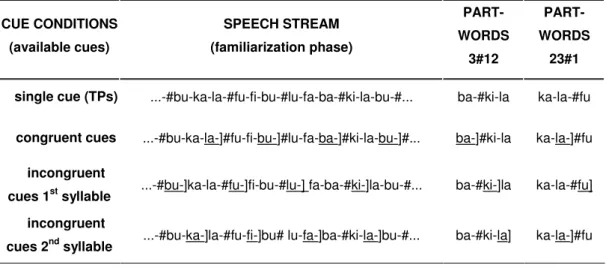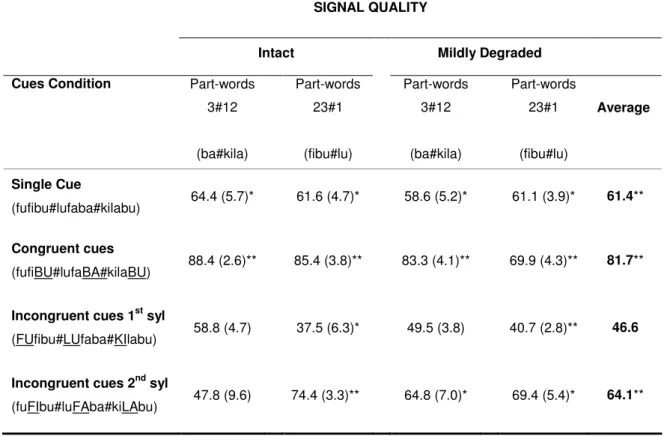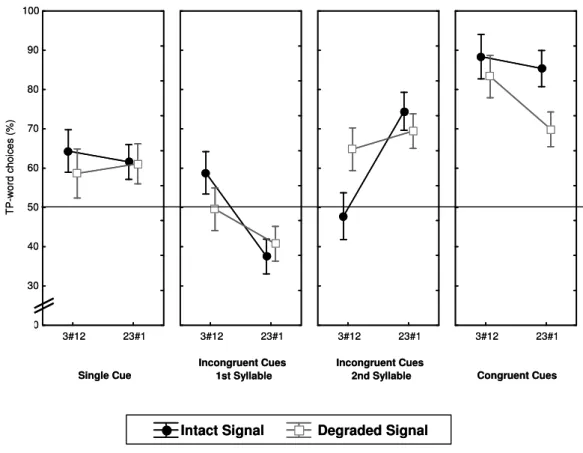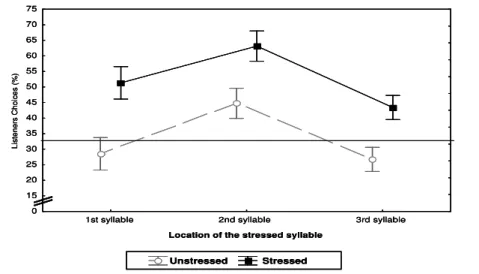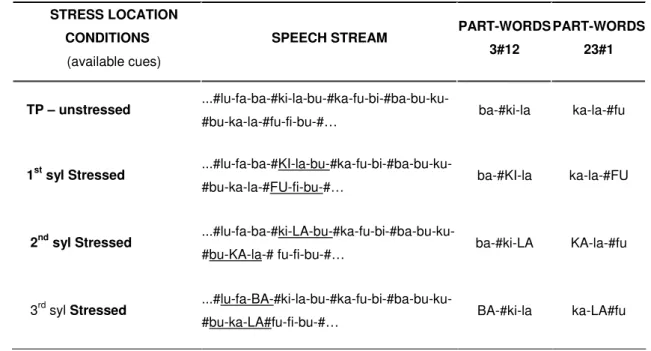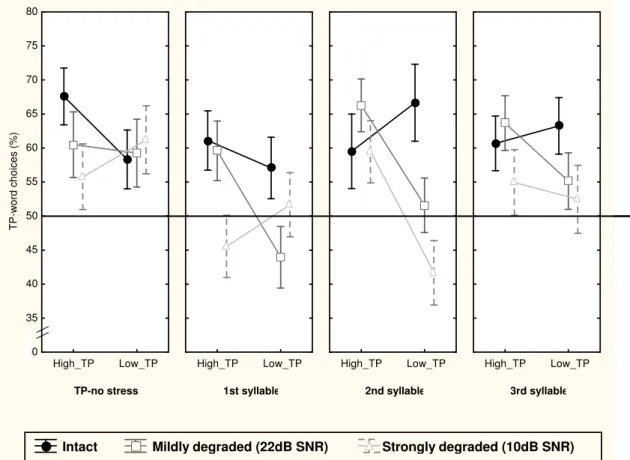Da corrente acústica à palavra : estádios do processamento da percepção da fala
Texto
(2) The present work was supported by a doctoral grant of Fundação para a Ciência e a Tecnologia – Ministério da Ciência, Tecnologia e Ensino Superior, Portugal, ref SFRH / BD / 12290 / 2003. Part of this research was also conducted under the Project POCI / PSI / 56901 / 2004 - “Visual phonology and auditory orthography”, funded by Fundação para a Ciência e a Tecnologia – Ministério da Ciência, Tecnologia e Ensino Superior – and European Community FEDER funding.. II.
(3) Palavras-chave: Segmentação da Fala; Aprendizagem de Línguas Artificiais; Automaticidade; Condições de Audição; Pistas sublexicais.. Key Words: Speech Segmentation;. Artificial. Language. Learning; Automaticity;. Listening. Conditions; Sublexical cues.. American Psychological Association (PsycINFO Classification Categories and Codes): 2300 Human Experimental Psychology 2326 Auditory and Speech Perception 2343 Learning and Memory 2346 Attention. III.
(4) IV.
(5) ACKNOWLEDGEMENTS. This was probably the most difficult section of this thesis to write. It is difficult to put into words (and even more difficult in just a few words) all the generosity I have received, both professionally and personally, throughout this scientific process. Since the beginning of my passion for Cognitive Psychology I had two mentors; my first words of gratitude will be for them. To Professor Carlos Brito#Mendes, who showed to me for the first time what the “black box” is capable of, who is a constant inspiration in all my work in science, and who I will never forget. To Paulo Ventura, my supervisor, who I esteem immensely as a scientist and as a person, for having shared with me these four years of work with friendship, and for all his help in this scientific process: theoretical reasoning, preparation of experimental materials, data analysis, discussion of results. In difficult times, when I most needed a friendly and encouraging comment, he was always there. I would also like to thank Régine Kolinsky, my co#supervisor, who I deeply admire, for all her generosity in accepting me as a PhD student, for sharing with me her objective and sharp reasoning, for many stimulating discussions, for all her support in my development as a research scientist, and for being a friend. Paulo and Régine have been a vital and constant source of reference and stimulation, while at the same time always allowing me to pursue an unconstrained research path in the directions that best suited my intellectual thirst and curiosity. To José Morais, I am sincerely grateful for all the stimulating, skeptical, and constructive questions that have enormously enriched this work, and for the conversations about Portugal and Literature. I would also like to express my grateful acknowledgement to: Sven Mattys, for sharing with me his theoretical insights and for having welcomed me at the University of Bristol; and Nicolas Dumay, the Language Group of the Psychology Department of the. V.
(6) University of Bristol, the members of the Unité de Recherche en Neurosciences Cognitives (UNESCOG) and of the Laboratoire de Psychologie Expérimentale of the Université Libre de Bruxelles, for having discussed my work. The writing of this thesis was enormously benefited by the comments of Paulo, Régine, José, and Sven. I would also like to thank to Cristina Carvalho, Sandra Fernandes and Luís Querido for all the help in running some of the experiments. To them and to Isabel Leite I am also thankful for their being always available and willing to help me. This thesis was partly supported by a doctoral grant awarded by the Fundação para a Ciência e a Tecnologia, Ministério da Ciência, Tecnologia e Ensino Superior, Portugal. Its support is here gratefully acknowledge. I would also like to thank to Centro de Psicologia Clínica e Experimental – Desenvolvimento, Cognição e Personalidade, at Faculdade de Psicologia e de Ciências da Educaça}o da Universidade de Lisboa, Portugal, and to the Department of Psychology of Universidade de Évora, as well as to all the students from the Universities of Lisboa and Évora who participated in the experiments reported in this thesis.. And last, but not least, I would like to thank to my closest ones. To my parents, who have supported (both economically and emotionally) all my development, who made me who I am, who accept me unconditionally. To Miguel, Lina, and Daniel for believing in my capabilities, even when I did not. To Pedro who honor me with genuine and enduring care, love, and words of support. To Beatriz and Filipa, for being true friends even through difficult times, and for all the philosophical conversations and interest in this work. To Carmen, Joaquina, and Carmencita who always share great moments with me in Brussels. This work is dedicated to my mother, who has always stimulated my curiosity, insisted on the importance of learning, and who supports me in everything since the very beginning # from whom I have received so much for so little.. VI.
(7) To Isilda. “Céptico como os cépticos, crente como os crentes. A metade que avança é crente, a metade que confirma é céptica. Mas o cientista perfeito é também jardineiro: Acredita que a beleza é conhecimento. (A pessoa bela tem um segredo. Descobriu algo).” Gonçalo M. Tavares, In “Breves Notas sobre Ciência”. VII.
(8) VIII.
(9) ABSTRACT. Until now, the weighting of general domain and speech-specific cues in speech segmentation was left largely unspecified. In the present work, the impact of different (qualitative and quantitative) listening conditions on the weighting of sublexical sources of information: segmental (transitional probabilities - TPs), suprasegmental (universal prosody and lexical stress) and subsegmental (coarticulation), was investigated in artificial language learning (ALL) settings, on the grounds of Mattys and colleagues theoretical framework. In Experiments 1-3B we evaluated the impact of physical noise on these cues. In Experiment 1, with intact speech, coarticulation overruled TPs. However, its role was highly modulated by signal-quality, while TPs were very resilient to noise. In Experiment 2, universal prosody like TPs was also highly resilient to physical noise, with the former prevailing over the latter, and driving the segmentation process. The impact of stress was rather different than the one of universal prosody. Stress pattern effects only emerged in degraded conditions (Experiment 2 and Experiment 3B). The impact of cognitive noise was evaluated in Experiments 4-6 through attention-load. In Experiment 3, the impact of cognitive noise on the weighting of TPs and coarticulation was in sharp contrast to the pattern found with physical noise. While coarticulation processing was largely unaffected by a reduction of attentional resources, TPs computation was penalized. In Experiments 5 and 6, we evaluated in a more fine-grained manner the impact of cognitive noise on TP-based segmentation. TPs computation is attentional-resources’ dependent. Yet, it occurs even when the AL is not the focus of attention and scarce resources are available, suggesting some automaticity of statistically-driven segmentation processes. In Experiments 7-9 we combined ALL settings with conventional experimental techniques, demonstrating that adult listeners are able to use on-line statistical information. Listeners actually treated statistical learning outputs as potential words - the output of ALL exhibits a lexical competition signature revealed by the inhibitory priming effect of novel neighbors (e.g., cathedruke) on lexical decisions to real words (e.g., cathedral) - but only when segmentation cues were congruent (Experiment 8). In Experiment 9, no effect of lexicalization was observed with incongruent cues. Thus, speech segmentation is largely the product of the available cues and of the listening conditions. Furthermore, these results suggest that current models of spoken-word recognition need to incorporate the role that congruency between segmentation cues play in both speech segmentation and word learning.. IX.
(10) X.
(11) RESUMO. O problema de Segmentação da Fala é um dos grandes desafios da Psicolinguística Cognitiva e é, também, o tema central do trabalho descrito nesta tese. Dois mecanismos mentais parecem estar envolvidos no processo de segmentação. Primeiro, múltiplos candidatos lexicais são activados e competem directamente para o reconhecimento (e.g., McQueen, Norris, & Cutler, 1994). Em segundo lugar, os ouvintes exploram múltiplos índices (ou pistas) sublexicais, disponíveis na corrente acústica. Estas pistas sublexicais podem ser, de forma geral, classificadas como: pistas suprasegmentais, relativas à prosódia (e.g., o acento lexical); pistas segmentais, a informação estatística relativa à sequência das unidades linguísticas (e.g., fonemas, sílabas) que ocorrem numa língua natural (i.e., probabilidades fonotácticas, Vitevitch & Luce, 1998, 1999) ou numa língua artificial (probabilidade transicional entre sílabas, Saffran, Aslin, & Newport, 1996a; Saffran, Newport, & Aslin, 1996b); e pistas subsegmentais relativas a aspectos acústicos de baixo-nível (e.g., a coarticulação, Mattys, 2004). Contudo, até ao momento actual, a maioria das investigações, devotadas ao tema do papel das pistas sublexicais na segmentação da fala em adultos, tem utilizado técnicas experimentais convencionais. Através destas técnicas, como o gating, o priming de modalidade cruzada, o word-spotting, e o registo dos movimentos oculares, o papel dos índices sublexicais na segmentação é indirectamente inferido de acordo com a activação lexical de candidatos compatíveis com o input linguístico. Portanto, o recurso a estes paradigmas não permite avaliar o papel dos índices sublexicais per se, uma vez que aspectos de activação e competição lexical (i.e., informação alto nível) estão igualmente envolvidos no desempenho dos ouvintes. Esta limitação não está presente no paradigma de Aprendizagem de Línguas Artificiais (ALAs) proposto por Saffran e col. (Saffran et al., 1996a, 1996b), permitindo o estudo de informação sublexical em condições de minimização da disponibilidade de informação de alto-nível. Saffran et al. (1996b) demonstraram, recorrendo ao Paradigma de ALA, que mesmo para ouvintes adultos, para quem a informação de alto-nível é prioritária no processo de segmentação, a informação de tipo estatístico é utilizada na segmentação. Neste paradigma, constituído por duas fases, os ouvintes são primeiro familiarizados com uma corrente acústica contínua composta pela concatenação de um repertório limitado de sílabas Consoante-Vogal. Nesta corrente contínua não existe nenhuma informação acústica que possa indicar ao ouvinte onde uma “palavra” (da LA) começa e onde acaba. Após a fase de familiarização, o ouvinte realiza um teste de escolha forçada onde, em cada ensaio, deverá decidir entre dois estímulos, qual deles corresponde a uma “palavra” da LA. A comparação do desempenho dos ouvintes com o nível do acaso permite avaliar se houve aprendizagem, uma vez que esta será expressa por um desempenho significativamente superior ao nível do acaso (i.e., o ouvinte escolheu com maior. XI.
(12) frequência os estímulos apresentados que na realidade eram “palavras” da LA do que os estímulos constituídos pelo mesmo repertório de sílabas mas que não eram “palavras” da LA). Uma vez que os estímulos, apresentados na segunda fase, ocorreram embebidos numa corrente acústica contínua durante a primeira fase, a observação de efeitos de aprendizagem sugere que os ouvintes são sensíveis à informação que está disponível na corrente apresentada, sendo capazes de utilizá-la ao serviço da segmentação da fala. Normalmente, a informação disponível corresponde a informação segmental de natureza estatística, i.e., a probabilidade transicional (PT) entre sílabas adjacentes. A PT corresponde à probabilidade com que uma primeira sílaba (X) é capaz de prever a que se lhe segue (Y), (i.e., PT = frequência XY / frequência X). De facto, não só numa LA, mas em qualquer língua natural, a probabilidade de uma sílaba prever a seguinte é maior, quando as duas sílabas pertencem à mesma palavra, do que quando ocorrem em posição adjacente na corrente mas com um ponto de segmentação entre si (Perruchet & Peereman, 2004; Swingley, 2005). Como esta computação estatística não exige qualquer conhecimento lexical, esta poderia ser a primeira pista de segmentação disponível aos bebés (Thiessen & Saffran, 2003), ocupando, por isso, uma posição central, não só na aquisição lexical, mas também na aquisição de outras pistas de segmentação (Mattys, White, & Melhorn, 2005). O paradigma de ALAs é também uma metodologia especialmente vantajosa para o estudo da segmentação da fala em adultos. Como a informação lexical (prioritária para o sistema perceptivo adulto) não se encontra disponível numa LA, este paradigma permite o estudo rigoroso do papel de diferentes fontes de informação sublexical na segmentação. O controlo sistemático da informação disponível e do tempo de exposição permitem igualmente a redução do conjunto de variáveis não controladas e a análise sistemática do papel de diferentes pistas de segmentação. Recentemente, Mattys e colaboradores (Mattys et al., 2005) apresentaram a primeira proposta teórica relativa à organização das diferentes fontes de informação, quer lexicais quer sublexicais, utilizadas ao serviço da segmentação da fala. Esta proposta considera que a segmentação da fala é produto, quer das fontes de informação que se encontram disponíveis, quer das condições interpretativas. As condições de audição têm um papel gradativo (e não de tipo tudo-ou-nada) na utilização de qualquer pista de segmentação. Nesta proposta teórica, os índices de segmentação encontram-se organizados hierarquicamente em três níveis. No nível superior da hierarquia encontra-se representada a informação lexical e pós-lexical, prioritária para a segmentação da fala em ouvintes com um léxico mental totalmente desenvolvido. Nos níveis inferiores estão representadas as informações sublexicais que terão um papel determinante na segmentação da fala, quando a informação lexical se encontra indisponível ou é reduzida. No segundo nível da hierarquia encontram-se informações de tipo segmental (estatístico) e subsegmental. Estas serão a informação determinante para a segmentação quando apenas informação sublexical se encontre disponível na corrente. O nível inferior da hierarquia corresponde à informação suprasegmental, de natureza prosódica, que funciona como heurística de último recurso em condições de fraca qualidade do sinal (e.g., sobreposição de ruído branco). Na investigação da segmentação da fala é fundamental adoptar uma perspectiva integrativa, no sentido em que, para além do estudo isolado de diferentes pistas de segmentação,. XII.
(13) estas fontes de informação deverão ser estudadas em condições combinatórias. Por outras palavras, o estudo integrado permite a compreensão de como diferentes fontes de informação são integradas (i.e., quando sugerem as mesmas hipóteses de segmentação, a disponibilidade de diferentes pistas terá um benefício na segmentação da fala?) e como são ponderadas (i.e., quando diferentes pistas de segmentação sugerem limites de palavra distintos, qual a pista considerada mais fidedigna?). Uma outra frente de investigação abordada no presente trabalho diz respeito às condições de audição. Tal como proposto por Mattys e col. (2005), estas condições têm um impacto modulador na ponderação das pistas de segmentação disponíveis na corrente (i.e., a fiabilidade das pistas depende largamente da qualidade do sinal), e estas condições não se circunscrevem apenas à qualidade física do sinal. Há mais no ruído do que a simples degradação física da corrente. Contudo, até ao presente, nenhum estudo investigou o papel de tipos de ruído qualitativamente diferentes na organização hierárquica das diferentes fontes de informação. Com o objectivo de avaliar o impacto das condições de audição na ponderação de diferentes tipos de informação sublexical, no presente estudo foi realizado um conjunto de experiências adoptando o paradima de ALAs. Nesta investigação, foi avaliado o impacto de ruído físico (i.e., sobreposição de ruído branco na corrente de fala a diferentes rácios sinal-ruído) e de ruído cognitivo (i.e., redução dos recursos atencionais disponíveis por realização de tarefas concorrente, atencionalmente exigentes), na ponderação de fontes de informação sublexical, representadas na proposta de Mattys e col., quer no mesmo nível (a co-articulação, informação de tipo subsegmental, acústico, de baixo-nível vs. a PT entre sílabas adjacentes, informação segmental estatística; e também entre diferentes tipos de informação suprasegmental – a prosódia universal vs. o acento lexical), quer em níveis diferentes (PTs vs. prosódica) da hierarquia. Nas Experiências 1-3B foi avaliado o impacto do ruído físico (i.e., por sobreposição de ruído branco ao sinal de fala) na ponderação dos três tipos de informação sublexical. Na Experiência 1, com sinal intacto, a coarticulação demonstrou-se uma pista de segmentação importante, superando o papel da informação estatística na segmentação. Contudo, o estatuto da informação coarticulatória é modelado pela qualidade física do sinal, enquanto a informação estatística se mantém resistente a uma degradação deste tipo. De facto, a informação estatística foi capaz de conduzir o processo de segmentação a níveis similares em condições de sinal intacto e de sinal fortemente degradado. Na Experiência 2, quer a informação prosódica universal, quer as PTs, demonstraram-se insensíveis a degradação física do sinal. Além disso, a informação prosódica foi a pista considerada mais fiável no processo de segmentação em qualquer condição de audição. O papel do acento lexical (i.e., informação suprasegmental, específica da língua em questão) na segmentação da fala (Experiência 3) é muito diferente do papel da informação prosódica universal. De facto, apenas em condições de ruído físico, se observaram efeitos do padrão de acento lexical na segmentação da fala. O impacto do ruído cognitivo (i.e., sobrecarga atencional) na ponderação das pistas sublexicais é muito diferente do impacto do ruído físico. Na Experiência 4, verificou-se que a. XIII.
(14) ponderação da informação estatística e da coarticulação observada em condições de ruído cognitivo é aproximadamente uma imagem em espelho da observada em condições de ruído físico. Em condições de redução drástica dos recursos atencionais disponíveis, a segmentação conduzida pela coarticulação não foi afectada, enquanto a informação estatística se revelou muito sensível a esta degradação. Nas Experiências 5 e 6, avaliámos de forma mais fina o impacto do ruído cognitivo na segmentação conduzida pela informação estatística. Nestas duas experiências foi demonstrado que a computação de PTs é dependente dos recursos atencionais, mas não de um mecanismo selectivo de atenção. Contudo, mesmo quando, os recursos atencionais disponíveis são drasticamente reduzidos, a informação estatística continua a ser capaz de conduzir o processo de segmentação. Nas três últimas experiências (Experiências 7-9) deste estudo combinámos técnicas convencionais com o paradigma de ALAs. Na Experiência 7, utilizando o word-spotting, apresentámos uma evidência directa da utilização on-line da informação estatística na segmentação da fala por ouvintes adultos. Nas Experiências 8 e 9 avaliámos qual a natureza das representações fonológicas extraídas de uma corrente continua por aprendizagem estatística. Na Experiência 8 foi demonstrado que ouvintes adultos tratam o output da aprendizagem estatística como potenciais palavras (i.e., efeito de priming inibitório dos novos vizinhos - produtos da segmentação da LA -; e.g., /fivDku/) na decisão lexical de palavras reais (e.g., fivela). Este estatuto lexical foi apenas observado quando as pistas de segmentação disponíveis na corrente de fala eram congruentes. Na experiência 9, em condição de pistas incongruentes, não foi observado qualquer efeito de lexicalização do output do procedimento de segmentação utilizado pelos ouvintes. Desta forma, a segmentação da fala é largamente o produto da ponderação das fontes de informação disponíveis na corrente, e das condições interpretativas (cf. Mattys et al., 2005). Para além disso, no presente trabalho é também sugerido que a ponderação das pistas sublexicais de segmentação depende de dois factores: (i) a sua “generalidade de domínio”; e (ii) o seu papel numa língua em particular (i.e., pista universal vs. pista específica da língua em questão; e.g., informação prosódica universal vs. acento lexical). Assim, o padrão de resultados observado neste estudo sugere que os modelos actuais de reconhecimento da palavra falada deverão incorporar a importância do papel da congruência das pistas de segmentação, bem como da natureza das mesmas, quer na segmentação da fala (i.e., processamento on-line), quer na aprendizagem de novas palavras (i.e., alterações estruturais de longo prazo).. XIV.
(15) Acronyms & symbols. Artificial Language ………………………………………………………………………........ AL Artificial Language Learning …………….………………………………………………..... ALL Adaptive Resonance Theory……………………………………………………………..….. ART Brazilian Portuguese ………...……………………………………………………………....... BP Consonant …………………...……………………………………………………………......... C Distributed Cohort Model …………….………………………………………………….... DCM European Portuguese ……………………………………………………………………......... EP Fundamental Frequency …….……………………………………………………………........ F0 Implicit Learning …………………………………………………………………………........ IL Inter-stimulus Interval ………………………………………………………………............... ISI Intonational Phrase ………….……………………………………………………………........ IP International Phonetic Alphabet …………………………………………………………...... IPA Long Term Memory ………...…………………………………………………………........ LTM Metrical Segmentation Strategy ……………….………………………………………........ MSS Neighborhood Activation Model …………………………………………………………... NAM Possible Word Constraint …………..…………………………………………………........ PWC Rapid Visual Serial Presentation ………………………….................................................. RVSP Reaction Time ….……………………………………………………………………….......... RT Stimulus Onset Asynchrony ………………………………………………………............... SOA Transitional Probability ………….………………………………………………………........ TP Universal Grammar ………………………………………………………………………...... UG Voice Onset Time ………………………………………………………………………....... VOT Vowel ………………….…...……………………………………………………………........... V Working Memory ………………………………………………………………………........ WM. XV.
(16) XVI.
(17) TABLE OF CONTENTS. PART I – THEORETICAL BACKGROUND 1. General Introduction ………………………………………………………………........ 3 1.1.. 1.2.. 1.3.. 1.4.. 1.5.. From the continuous stream into discrete units of meaning …………………………... 5 1.1.1.. In the beginning there was the word ……………………………………………….. 5. 1.1.2.. Crossroads into the speech stream ………………………………………………….. 10. 1.1.3.. T_issues and issues …………………………………………………………………. 18. Conventional Experimental Paradigms ……………………………………………….... 23 1.2.1.. Gating ……………………………………………………………………….. 23. 1.2.2.. Word-spotting ………………………………………………………………………. 24. 1.2.3.. Eye-tracking ………………………………………………………………….. 25. 1.2.4.. Cross-modal priming ………………………………………….………………. 29. The Artificial Language Learning Paradigm …………………………………………... 31 1.3.1.. ALL and Implicit Learning ……………………………………………………….... 33. 1.3.2.. ALL and Speech Segmentation …………………………………………………….. 35. The hierarchical organization frame of Mattys and colleagues ……………………….. 37 1.4.1.. Experimental evidences …………………………………………………………….. 38. 1.4.2.. Developmental and cross-linguistic implications …………………………………... 39. An overview of the present thesis ……………………………………….……………….. 42 1.5.1.. The weighting of different sublexical sources of information in speech segmentation ……………………………………………….………………... 43. 1.5.2.. The listening conditions …………………………………………….………………. 46. 1.5.3.. An on-line evidence of statistical speech segmentation ……………………………. 51. 1.5.4.. The nature of speech segmentation outputs ………………………….……………... 54. PART II – EMPIRICAL CHAPTERS 2.. Statistical and Coarticulatory Cues to word boundaries ……………….………….... 61 2.1.. Introduction …………………………………………………………….………….. 61 2.1.1.. Coarticulation – a subsegmental cue …………………………………….………….. 63. 2.1.2.. TPs – a segmental cue …………………………………………………….……….... 64. XVII.
(18) Experiment 1. TPs and Coarticulation in Physical Noise 2.2.. 3.. Method ……………………………………………………………………………………. 68 2.2.1.. Participants …………………………………………………………………………. 68. 2.2.2.. Material …………………………………………………………………………….. 68. 2.2.3.. Procedure ………………………………………………………………………….... 74. 2.3.. Results and Discussion ………………………………………………………………….... 75. 2.4.. General Discussion ……………………………………………………………………….. 80. Universal and Speech-specific Prosodic cues in ALL ……………………………….. 89 3.1.. Introduction ………………………………………………………………………………. 89 3.1.1.. The interaction between Prosody and TPs in speech segmentation ……….………... 91. 3.1.2.. An overview of the experiments ………………………………………….……….... 96. Experiment 2. Domain-general vs. Speech-specific Universal cues in segmentation 3.2.. 3.3.. Method ……………………………………………………………………………………. 101 3.2.1.. Participants …………………………………………………………………………. 101. 3.2.2.. Material …………………………………………………………………………….. 102. 3.2.3.. Procedure ………………………………………………………………………….... 105. Results and Discussion ………………………………………………………………….... 106 Experiment 3A. Duration is an acoustic correlate of word primary stress in EP. 3.4.. 3.5.. Method ……………………………………………………………………………………. 114 3.4.1.. Participants …………………………………………………………………………. 114. 3.4.2.. Material …………………………………………………………………………….. 115. 3.4.3.. Procedure ………………………………………………………………………….... 116. Results and Discussion ………………………………………………………………….... 117 Experiment 3B. Domain-general vs. Language-specific cues in segmentation. 3.6.. 4.. Method ……………………………………………………………………………………. 122 3.6.1.. Participants …………………………………………………………………………. 122. 3.6.2.. Material …………………………………………………………………………….. 123. 3.6.3.. Procedure ………………………………………………………………………….... 124. 3.7.. Results and Discussion ………………………………………………………………….... 125. 3.8.. General Discussion ……………………………………………………………………….. 131. Statistical and Coarticulatory Cues in Cognitive Noise …………………………….. 141 4.1.. Introduction ………………………………………………………………………………. 141. XVIII.
(19) 4.1.1.. Statistics and coarticulation: the impact of physical noise …………………………. 142. 4.1.2.. The impact of cognitive noise …………………………………………………….... 143. Experiment 4. The impact of cognitive noise on the relative weighting of speech segmentation cues 4.2.. 4.3.. 4.4.. 5.. Method ……………………………………………………………………………………. 149 4.2.1.. Participants …………………………………………………………………………. 149. 4.2.2.. Material …………………………………………………………………………….. 149. 4.2.3.. Procedure ………………………………………………………………………….... 152. Results …………………………………………………………………………………….. 154 4.3.1.. Detection of Repetition in RSVP …………………………………………………... 154. 4.3.2.. ALL performance …………………………………………………………………... 156. Discussion …………………………………………………………………………………. 159. Attention in ALL ………………………………………………………………………. 167 5.1.. Introduction ………………………………………………………………………………. 167 5.1.1.. Statistically-driven speech segmentation and IL ………………………………….... 169. 5.1.2.. The role of attention in statistical learning …………………………………………. 170. 5.1.3.. An overview of the experiments ………………………………………………….... 174. Experiment 5. Exposition Time and Attentional resources in ALL 5.2.. 5.3.. Method ……………………………………………………………………………………. 178 5.2.1.. Participants …………………………………………………………………………. 178. 5.2.2.. Material …………………………………………………………………………….. 178. 5.2.3.. Procedure ………………………………………………………………………….... 179. Results and Discussion ………………………………………………………………….... 181 5.3.1.. RSVP Task …………………………………………………………………………. 181. 5.3.2.. ALL ……………………………………………………………………………….... 182. Experiment 6. Intention to learn in ALL 5.4.. 5.5.. 5.6.. Method ……………………………………………………………………………………. 191 5.4.1.. Participants …………………………………………………………………………. 191. 5.4.2.. Material …………………………………………………………………………….. 191. 5.4.3.. Procedure ………………………………………………………………………….... 192. Results and Discussion ………………………………………………………………….... 193 5.5.1.. RSVP Task …………………………………………………………………………. 193. 5.5.2.. ALL ……………………………………………………………………………….... 194. General Discussion ……………………………………………………………………….. 198. XIX.
(20) 6.. On-line measures and lexicalization during ALL ………………………………….... 209 6.1.. Introduction ………………………………………………………………………………. 210 6.1.1.. The nature of statistical segmentation outputs ……………………………………... 213. 6.1.2.. An overview of the experiments ………………………………………………….... 216. Experiment 7. On-line statistically-driven speech segmentation 6.2.. 6.3.. Method ……………………………………………………………………………………. 220 6.2.1.. Participants …………………………………………………………………………. 220. 6.2.2.. Material …………………………………………………………………………….. 220. 6.2.3.. Procedure ………………………………………………………………………….... 222. Results and Discussion ………………………………………………………………….... 223 6.3.1.. Spotting Responses …………………………………………………………………. 223. 6.3.2.. RT data ……………………………………………………………………………... 226. Experiment 8. The status of statistical segmentation outputs 6.4.. 6.5.. Method ……………………………………………………………………………………. 232 6.4.1.. Participants …………………………………………………………………………. 232. 6.4.2.. Material …………………………………………………………………………….. 232. 6.4.3.. Procedure ………………………………………………………………………….... 240. Results and Discussion ………………………………………………………………….... 240 6.5.1.. ALL performance …………………………………………………………………... 240. 6.5.2.. Lexicalization test …………………………………………………………………... 242. Experiment 9. The status of the output of the segmentation procedure adopted by listeners 6.6.. 6.7.. 6.8.. Method ……………………………………………………………………………………. 249 6.6.1.. Participants …………………………………………………………………………. 249. 6.6.2.. Material …………………………………………………………………………….. 250. 6.6.3.. Procedure ………………………………………………………………………….... 251. Results and Discussion ………………………………………………………………….... 251 6.7.1.. ALL performance …………………………………………………………………... 251. 6.7.2.. Lexicalization test …………………………………………………………………... 253. General Discussion ……………………………………………………………………….. 256. PART III – GENERAL DISCUSSION AND CONCLUSIONS 7.. General Discussion …………………………………………………………………….. 273 7.1.. Main findings of the present study …………………………………………………….... 274 7.1.1.. Speech segmentation with physically degraded signal ………………………….…. 274. XX.
(21) 7.2.. 7.3.. 7.1.2.. Speech segmentation in cognitive noise ……………………………………………. 280. 7.1.3.. Cognitive noise and statistically-driven speech segmentation ……………………... 282. 7.1.4.. The ALL paradigm revised ……………………………………………………….... 286. Theoretical framing of the present results …………………………………………….... 289 7.2.1.. A theoretical proposal – the nature of the available sources of information ……….. 291. 7.2.2.. The nature of statistical segmentation output …………………………………..…... 299. Some unanswered questions ……………………………………………………………... 309 7.3.1.. Compatibility between sublexical segmentation cues,. prelexical units and lexical mechanisms ……………………………………………………... 309 7.3.2.. Cross-species statistical learning ………………………………………………….... 316. 7.4.. The Artificial Language Learning Paradigm revisited ………………………………... 320. 7.5.. Thoughts for future research ……………………………………………………………. 322. 7.6.. In sum ……………………………………………………………………………………... 324. 8.. References …………………………………………………………………………….... 327. 9.. Appendices ……………………………………………………………………………... 363 9.1.. Appendix I ……………………..……………………………………………….…. 365. 9.2.. Appendix II ……………………..…………………………………………………. 367. 9.3.. Appendix III ………………………………..……………………………………... 369. 9.4.. Appendix IV …………………………...…………………………………………... 373. 9.5.. Appendix V ……..…………………………..……………………………………... 375. 9.6.. Appendix VI ……....……………………………...………………………………... 377. XXI.
(22) INDEX OF TABLES. Table 1: Orthographic translation of a sample of the stream heard in the familiarization phase in the three cue conditions of Experiment 1. ……………………………………………………………...….............. 70. Table 2: Performance pattern (proportion of TP-Word responses, in percentage) according to cue condition (single cue; congruent cues; incongruent cues) and Signal Quality (intact speech; 22dB SNR; 10dB SNR), in Experiment 1, considering the TP gradient of the TP-words of the AL (High-TP; low-TP) …….…………………......... 76. Table 3: Orthographic translation of a sample of the stream heard in the familiarization phase in the four cues conditions and of the AL-stimuli (TP-words; Part-words 3#12; Part-words 23#1) of Experiment 2. ……..………......... 101. Table 4: Average proportions of TP-word responses (in percentage), separately for cues condition (single cue; incongruent cues - 1st syl; incongruent cues - 2nd Syl; and congruent cues) and signal quality condition (Intact vs. Mildly Degraded), considering Part-words type (3#12 vs. 23#1) in Experiment 2. ……………………...... 107. Table 5: Orthographic translation of a sample of the stream heard in the familiarization phase in the four conditions of stress location of Experiment 3B. …..………………………………………………............... 124. Table 6: Average proportions of TP-Word responses (in percentage) in Experiment 2B, separately for each inputintelligibility condition (intact; mildly degraded; strongly degraded) and lexical stress location (TP-unstressed; 1st syllable; 2nd syllable; 3rd syllable), considering the TP-level of the AL-words (high- vs. low-TP). ……......... 127. Table 7: Performance pattern (mean percentage of Correct Detections – CD – and false alarms – FA) for the Three AL-conditions, according to the number and congruence of segmentation cues available (single cue; congruent cues – congruent -; incongruent cues – incongruent), in the RSVP task, according to visual block (block1; block 2; block 3) and d’ scores in Experiment 4. ….…….…….…………………………... 155. Table 8: Average proportions of TP-Word responses (in percentage), separately for each cue condition (single cue; congruent cues; incongruent cues) and cognitive noise condition (low vs. high load), considering the TP- gradient of the AL words (high- vs. low-TP-words) in Experiment 4. ……...………………......... 157. Table 9: Average proportions of TP-Word responses (in percentage), separately for each familiarization time (7-; 14-; and 21-min) and attentional load (low vs. high load) condition, considering the TP level of the AL words (high- vs. low-TP-words) in Experiment 5. …………….……………………………........ 183. XXII.
(23) Table 10: Average proportions of TP-Word responses (in percentage), separately for each learning condition (Incidental and Intentional) and attentional resources condition (low-attention vs. high-attention load), considering the TP-level of the AL words (high- vs. low-TP-words) in Experiment 6. …....….…….……………......... 195. Table 11: Examples of materials used (in phonological form, according to IPA) in the AL familiarization phase (AL-Fam.), two-forced choice (ALL-test), and lexicalization test (Lexical Decision – LD on base-words) in Experiment 8, separately for the two artificial languages (ALs: ALA and ALB). …………………............ 231. Table 12: Base-Words characteristics by block (Blocks A and B; Experiment 8 and 9: mean log frequency; neighborhood density, mean transitional probability (TP between first and second syllable), Uniqueness Point (UP), and mean duration (in ms), as well as t-values (all ps > .5). ….….…………………......... 233. Table 13: Mean RTs (measured from target onset) for Base-Words A and B (BWd A; BWd B) and the Priming Effect (P.E., the difference in lexical decision latencies between primed and unprimed conditions) separately for each AL-condition (ALA and ALB) and moment of testing (Immediately and Post-1 week) in Experiment 8. ….. 243. Table 14: Examples of materials used in AL-familiarization phase (AL-Fam.), ALL-test, and Lexicalization test (Lexical Decision – LD on Base-Words) on Experiment 9, regarding the two Artificial Languages (ALs). …..…………........ 248. Table 15: Mean RTs (measured from target onset) for Base-Words A and B (BWd A; BWd B) and the Priming Effect (P.E., the difference between primed and unprimed conditions) separately for each AL-condition (ALA2 and ALB2) and moment of testing (Immediately and Post-1 week) in Experiment 9. ……….…………......... XXIII. 253.
(24) INDEX OF FIGURES. Figure 1: Hierarchical organization of speech segmentation cues according to listening conditions, as proposed by Mattys and colleagues. The triangle represents the weighting of segmentation cues as well as their resilience to physical degradation of the signal (i.e., the base of the triangle corresponds to the strongest sensitivity to physical noise)…………………………………............................................... 38. Figure 2: Performance pattern (proportion of TP-Word responses, in percentage) according to cue condition (single cue; congruent cues; incongruent cues) and of the signal quality (intact speech; 22dB SNR; 10dB SNR) – Experiment 1. ………………………………………………………………….…......... 78. Figure 3: ALL performance pattern (proportion of AL-word responses, in percentage), in Experiment 2, broken-down by Part-word Type (3#12; 23#1), according to Input-Intelligibility (Intact; Degraded) and Cues available (single cue; incongruent cues first syllable; incongruent cues second syllable; congruent cues). .…...…………......... 108. Figure 4: Listeners’ proportion of responses on the three-alternative forced choice stress location task on AL-stimuli, broken-down by syllable detection responses (1st syl; 2nd syl; 3rd syl) in the two acoustic cue conditions (Unstressed vs. Stressed) in Experiment 3A. …………………..…………………………......... 117. Figure 5: Performance pattern (proportion of AL-word responses, in percentage) broken-down by TP-level (High-TP; Low-TP) of AL-words, according to Signal condition (Intact; mildly degraded - 22dB SNR; strongly degraded – 10dB SNR) and Lexical Stress location (TP – No stress; 1st Syllable; 2nd Syllable; 3rd Syllable) in Experiment 3B. Vertical bars denote standard error of the mean on each condition. …………………………....... 126. Figure 6: Performance pattern (proportion of AL word responses, in percentage) broken-down by TP level (High-TP-words; Low-TP-words), according to attentional load condition (High-attention Load; Low-attention Load) and familiarization time (7-min; 14-min; 21-min), in Experiment 5. …………….…………......... 184. Figure 7: Performance pattern (proportion of AL-word responses, in percentage) broken-down by TP level (High-TP-words; Low-TP-words) of AL words, according to attentional resources condition (Figure 7a: High-attention Load; Figure 7B: Low-attention Load) and learning condition (Incidental learning; Intentional learning) in Experiment 6. ………………………………………..….………………......... 196. Figure 8: Mean Adjusted RT (in ms; from AL-stimuli offset) for trisyllabic responses in spotting TP-words and part-words, separately for initial and final AL-stimuli-bearing sequences (in the Preceding vs. Following lists, respectively), in Experiment 7.. ….….….……………………………………………........ 227. XXIV.
(25) Figure 9: Mean percentage of TP-word choices in the ALL-test (i.e., two-alternative forced choice test) for each participant, according to the moment of testing: immediately after the AL-familiarization phase (i.e., immediate) and one week after with no intervening AL-familiarization period in Experiment 8. ….…...……..…......... 241. Figure 10: Effects of AL-familiarization, according to the AL to which listeners were exposed (LA; LB), on lexical decision’s response to existing lexical items immediately after AL-familiarization: Mean RTs (in milliseconds) for the two blocks of Base-Words (Base-Words A; Base-Words B) in Experiment 8 …….….……......... 244. Figure 11: Inhibitory Effect (computed as the difference between lexical decision latencies to the primed block of Base-Words and the unprimed Block of Base-Words), according to the AL to which listeners were exposed (ALA; ALB) and the moment of testing (Immediately after and 1-week after) in Experiment 8. …………..... 246. Figure 12: Mean percentage of TP-word choices in the ALL-test for each participant, according to the moment of testing: immediately after the AL-familiarization phase (i.e., immediate) and one week after with no intervening AL-familiarization period, in Experiment 9. ….….….……………………………………......... 252. Figure 13: The theoretical proposal outlined in the present thesis allied with Mattys and colleagues proposal for language-specific cues (see also Figure 1 in section 1.4. of chapter one) …….…….….………......... XXV. 293.
(26) PART I THEORETICAL BACKGROUND.
(27) Chapter 1. General Introduction. 2.
(28) Chapter 1. General Introduction. Chapter 1. General Introduction “(…) meus ombros se retesavam não pelo que eu via, mas no afã de captar ao menos uma palavra. Palavra? Sem a mínima noção do aspecto, da estrutura, do corpo mesmo das palavras, eu não tinha como saber onde cada palavra começava ou até onde ia. Era impossível destacar uma palavra da outra, seria como pretender cortar um rio à faca…” Chico Buarque (2004), In “Budapeste”. Understanding speech in our native language is accompanied by a subjective impression of “hearing” a discrete series of word-units clearly separated from one another. However, when we hear a speaker of a foreign language, our subjective impression is rather different. In that situation, any first attempt to segment the speech flow would be like “trying to cut a river with a knife” (Buarque, 2004). This is in fact closer to the objective reality: The speech stream (either in our native language or in an unknown one) is a continuous stream with few reliable cues to word-boundaries (e.g., Klatt, 1980; Liberman & Studdert-Kennedy, 1978). Thus,. 3.
(29) Chapter 1. General Introduction. Understanding how we parse this quasi-continuum signal into discrete lexical units is one of the main challenges faced by psycholinguistic research. This is the primary focus of the research reported on this thesis, in the context of a full, mature speech perception system. In 1987, Frauenfelder and Tyler stated, in their manuscript on Cognition’s special issue about spoken word recognition, that until that moment in psycholinguistic History “spoken word recognition has been a neglected area of study”. After twenty years, a vast bulk of research has been devoted to this cognitive. domain, in particular to speech segmentation. The speech segmentation problem is the main focus of the present thesis. In this chapter I will present the mechanisms involved in speech segmentation – highlevel word recognition and signal derived sources of information – as well as the evidences demonstrating that even in adulthood both types of mechanisms act together in speech segmentation. The conventional paradigms demonstrating the role of sublexical segmentation cues in adulthood will be also outlined. The artificial language learning paradigm implemented by Saffran and colleagues (Saffran, Aslin, & Newport, 1996a; Saffran, Newport, & Aslin, 1996b) will be described as a potential fruitful tool for understanding the role of sublexical cues in the absence (or almost so) of available high-level information. The association between this paradigm and the Implicit Learning field, as well as the empirical speech segmentation evidences derived from studies using this paradigm will also be described. After contextualizing the segmentation mechanisms on the grounds of empirical evidences, the theoretical framework that underlie the study described in the present thesis will be presented (i.e., the hierarchical organization frame of. 4.
Imagem

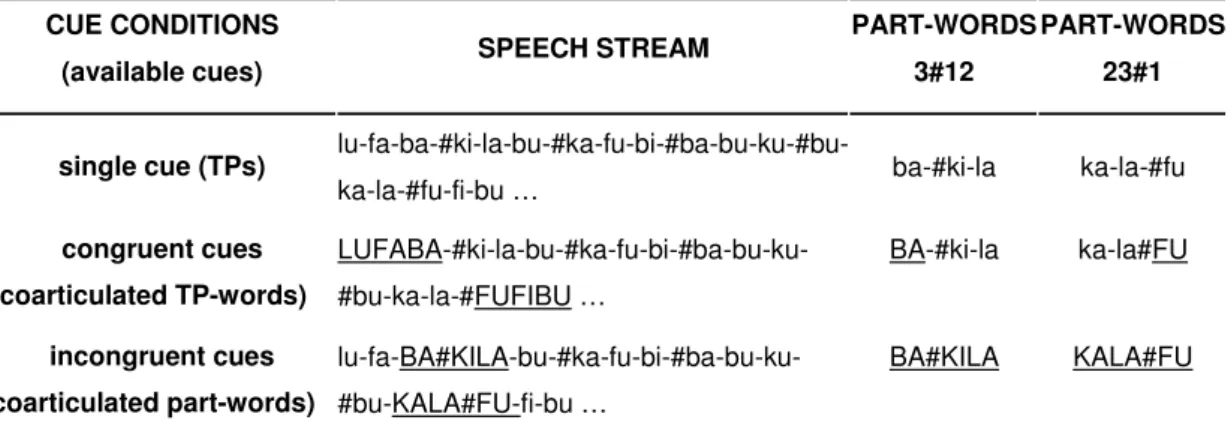
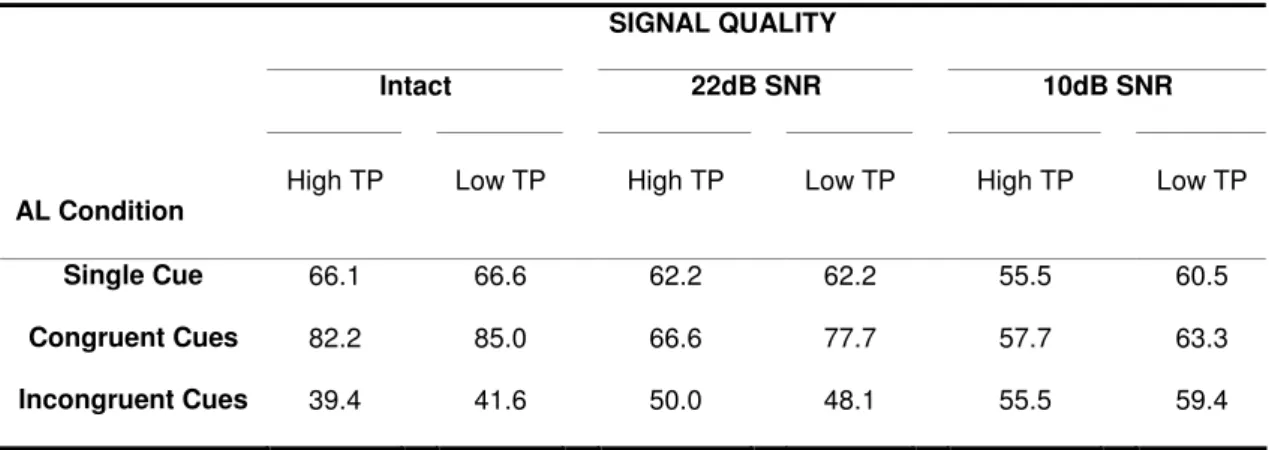
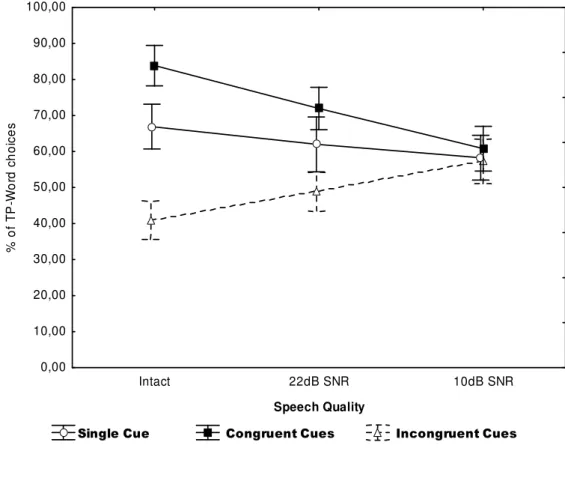
Documentos relacionados
Biochemical results suggest that ALK1 is crucial for the anti-angiogenic activities of BMP-9 observed in the Matrigel assay, and mediators other than (or in addition to) SMAD1/5/8
Conclusions: Discrimination training with multimodal stimuli consisting of visual and odour cues leads to stimulus specific changes in the in vivo responses of the mushroom body of
Figure 1 - Number of responses for each dimension and percentage of positive, neutral and negative responses for the twelve dimensions of patient safety culture according to
concluded that because of the higher prevalence of HBS, HCV and HIV positivity among blood donors who chose the conidential unit exclusion (CUE) option, ofering CUE to blood donors
concluded that because of the higher prevalence of HBS, HCV and HIV positivity among blood donors who chose the confidential unit exclusion (CUE) option, offering CUE to blood donors
The modulatory effects of visual and semantic cues under different olfactory conditions were first explored with a repeated measures ANOVA, using the proportion of button responses
Figure 2. Learning and memory assessed by fear conditioning and water maze tests. A) Fear conditioning: percentage of freezing in the context and cue tests of memory 24 hours
that the pattern of differences in men’s perception of the attractiveness of facial, vocal, and olfactory cues in different groups of women (young girls, adult women, and
